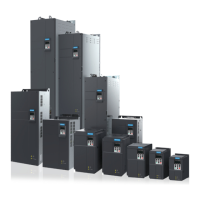6. Description of Parameters
- 133 -
6.5.4 Voltage Limit and Braking Unit Applied Voltage
When bus voltage rises above the value set in F3-22, the motor becomes regenerative. This
function prevents overvoltage trips by adjusting the output frequency to extend deceleration time
in this case.
If actual deceleration time cannot satisfy the requirement, increase the value of F3-10 (V/F over-
excitation gain) adequately.
Figure 6-42 Voltage limit
Time
Time
Output
frequency
Time
Time
Voltage limit
Voltage limit
Time
Time
Voltage limit
during acceleration
Voltage limit
during constant running
Voltage limit
during deceleration
Bus
voltage
Bus
voltage
Bus
voltage
Output
frequency
Output
frequency
Voltage limit
Voltage limit
Voltage limit Voltage limit
Function Code Parameter Name Setting Range Default
F3-22
Voltage limit 650 to 800 V 760 V
F3-23
Voltage limit selection 0: Disabled
1: Enabled
1
F3-24
Frequency gain for voltage limit 0 to 100 30
F3-25
Voltage gain for voltage limit 0 to 100 30
F3-26
Frequency rise threshold during
voltage limit
0 to 50 Hz 5 Hz
F9-08
Braking unit applied voltage 650 to 800 V 760 V
F3-10
V/F over-excitation gain 0 to 200 64
F3-11
V/F oscillation suppression
gain
0 to 100 40
F9-03
Overvoltage protection gain 0 (no overvoltage stall) to 100 30
F9-04
Overvoltage protection voltage 650 to 800 V 770 V
When using braking resistor, braking unit or energy feedback unit, pay attention to
the following aspects:
● Set F3-10 (V/F over-excitation gain) to 0. Otherwise, too large current may occur
during drive running.
● Set F3-23 (overvoltage suppression selection) to 0 (disabled). Otherwise, the
deceleration time may become longer.

